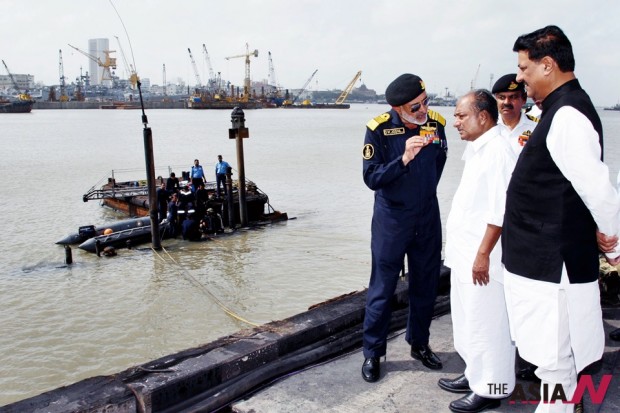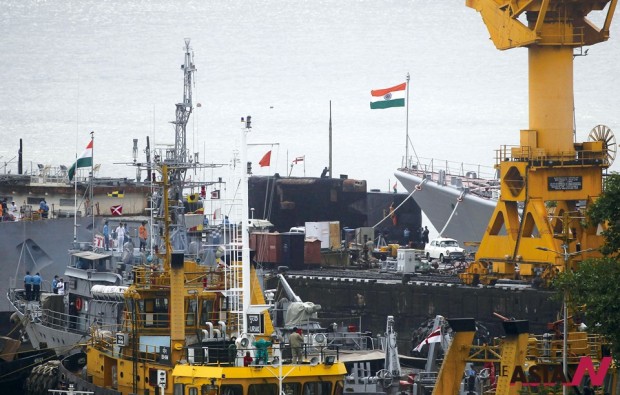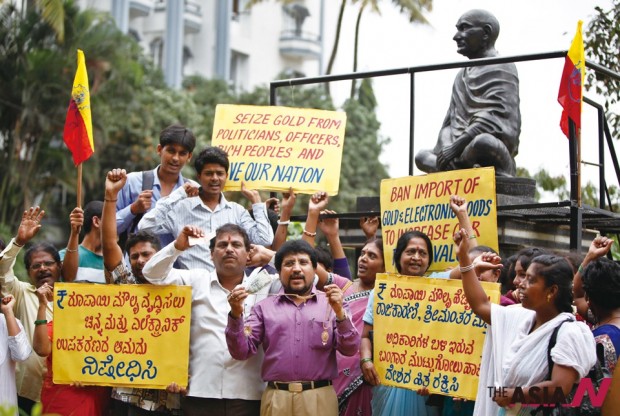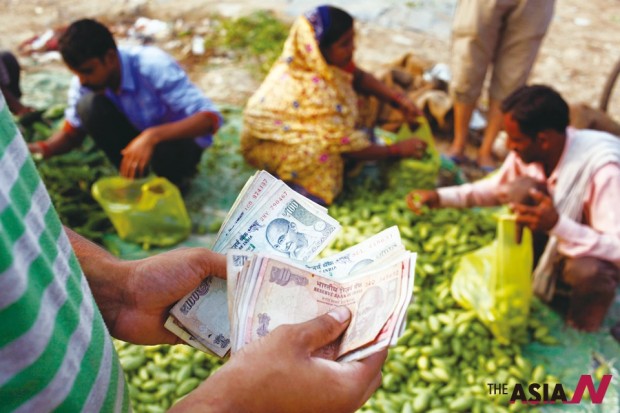India’s superpower hopes take a beating

In this Aug. 14, 2013 photo released by the Indian Navy, Indian Defense Minister A.K. Antony, center, listens to Navy Chief Admiral D.K. Joshi as navy personnel inspect a Russian-made submarine, INS Sindhurakshak, at a naval dockyard where it caught fire and sank after twin explosions, in Mumbai, India. <Xinhua/NEWSis>
India’s hopes of becoming a superpower are up in flames, at least for the present. While policy-makers in New Delhi fiddled as the economy wobbled, it suffered a devastating setback when one of its Russian-built submarines was destroyed in a fire set off by a series of explosions last August, a day before the country’s 67th Independence Day celebrations.
The blasts, from on board munitions, also killed 18 sailors. Most of its 58-strong crew, including its commanding officer, were lucky―they were on shore at the time of the blasts. The destruction of the 16-year-old INS Sindhurakshak is seen as depleting India’s already small submarine fleet – it has just 14 submarines, one third the number of China. Only nine of its submarines were operational before the fire and, according to published reports, just five or six are operating at any given time―too few to guard India’s extensive coastline adequately, and so very few that India’s ambition to become a superpower will have to put on hold for a very long time.
A submarine explodes
C. Uday Bhaskar, retired Indian Navy Commodore and a former director of New Delhi-based naval think-tank National Maritime Foundation, was cited in a Wall Street Journal report as saying that the Sindhurakshak blasts were likely to be the worst naval accident in the country since India launched its first submarine in 1967.
Indian Navy Rear Admiral Pradeep Kaushiva, the current director of the National Maritime Foundation, told the newspaper that for various reasons, such as decision making, longer acquisition protocols and availability of funds, India’s fleet modernization programmes and the induction of new submarines are not on track.
“The fleet is far more aged than we would have liked,” he said. “The number of submarines that are operational, because of those that are undergoing repairs, is less than was planned. There is a rolling plan for re-stocking the fleet and this hasn’t been met because production of new vessels has been deferred. And because the fleet is already small if one or two are out of action, that makes a big difference.”
Making up for that difference to recoup and build its defence and combat capabilities as swiftly as a country with superpower aspirations would like will not be easy as New Delhi has been failing repeatedly to take timely decisions. Allegations are rife of deep-rooted corruption in defence purchases. Mismanagement, as in various other sectors, is a staple feature.
A recent report in the Times of India, a leading newspaper, gives some telling examples: “The first of the six new Scorpene submarines being built at Mazagon Docks [in Mumbai] will be ready only by 2016~17 at the earliest, over four years behind schedule.” A light combat aircraft (LCA), “already 30 years in the making, was slated to replace the obsolete MiG-21 in the 1990s but is still at least two years away from becoming fully-operational.”
If defence and combat capabilities are under strain, India’s economy is under serious threat. Some critics bluntly say that it is collapsing, having fallen prey to serious policy errors, raging corruption, poor infrastructure and an unfriendly business climate made worse through imposition of retrospective tax levies as was done in last year’s budget.
Anders Aslund, Senior Fellow at the non-profit Peterson Institute for International Economics, has given this description of India’s economy and its government: “Its inflation is too high, its budget deficit, public spending, and current account deficit are too large. Governance is mediocre at best, reflecting substantial corruption and a poor business environment.”
Inflation is nearly 10 per cent, affecting the poor the hardest, the budget gap reached 4.9 percent of Gross Domestic Product in the 12 months ended March. The current account deficit, eroding foreign exchange reserves and putting downward pressure on the rupee, the national currency, hit a record high of 5.4 per cent of GDP. The economy grew at just 4.4 per cent in the first quarter of the current financial year, the slowest pace in the last four years. Analysts say even this rate of growth may be difficult to sustain as the budget shortfall makes it difficult for the government to keep up expansionary spending.

An Indian navy sailor works atop a sail of a submarine, center, at a naval dockyard where a submarine caught fire and sank after an explosion in Mumbai. <AP/NEWSis>
Economy in a swoon
Industrial output fell 2.2 per cent year-on-year in June, with investment demand falling and spending plans by large firms on the decline. The rupee, spiralling down to become one of the world’s worst performers, has fallen by nearly 20 per cent since May; stock markets have been taking hysterical dives before showing signs of stabilizing while foreign investors tended to herd out fast from financial markets, adding to the downswing of the rupee and stocks.
According to data from India’s central bank, the Reserve Bank of India, mentioned in a Bloomberg News report, international investors reduced their holdings of Indian bonds by $10 billion since a peak in May to $28 billion at one stage, the lowest since January 2012. Concern the U.S. central bank will scale down stimulus measures was a factor in this reduction.
More than external pulls, however, what foreign investors consider a harassing investment climate has led to them to be wary about dispatching their funds to India. One prime example is that of steel giant ArcelorMittal revising its decision to build a multi-billion steel plant in India. It complained about delays in acquiring land and failure to ensure captive iron ore security, which it said, was necessary to go ahead with the project.
Even local investors, finding interest costs too high and regulations too troublesome, have been seeking pastures overseas. Data from the central bank cited in a news report shows that $7.6 billion of Foreign Direct Investment flowed into India between April and June 2013, but $11.2 billion left the country in the same period.
Those joining the capital flight were not just some major Indian companies, but even smaller firms. The authorities reacted to the flight of domestic capital by putting limits on direct investments overseas by local companies and individuals, raising fears of reintroduction of capital controls prevalent before the economic reforms of 1991.

A member of a social organization holds gold ornaments and Indian currency notes and shouts slogans along with others during a protest asking the government to ban import of gold. <AP/NEWSis>
Policy failures, pervasive corruption
Those reforms, based on relaxing draconian Soviet-style controls on industry, trade and foreign investments, were forced by an acute balance of payments crisis that had compelled the government to do what was seen as a national humiliation – pledge its gold reserves to pay its import bills. India’s foreign exchange reserves then had fallen to $3 billion, not enough even to cover three weeks of imports. The situation is not quite the same now as the country has around $280 billion of foreign exchange reserve, which is sufficient to finance nearly seven months of imports.
But daily reports, magnified by the electronic media, of the rupee crashing, stocks gyrating and news of foreign investors pulling out have created a sense of panic. Pain is severe for the vast majority of people, especially as soaring inflation is forcing them to pay higher prices for everything from groceries, vegetables to cooking gas, petrol, diesel and travel. Lower growth is routing the hopes of job seekers. A poll by a premier newspaper showed the current period could perhaps be the worst job market since liberalisation in the 1990s in terms of severity, duration, sweep and scale.
The pain the economy is inflicting on the people is the result of deviation from economic logic, which required deep structural and other reforms to step up growth. What appears astonishing is that since coming to power after the 2004 general election, the Congress-led United Progressive Alliance (UPA) government has carried out no significant reforms. Only now, in desperation at the state of the economy, has it made a few reform moves, which critics say, are too patchy and too late to make a difference to the economy.
As is well known, political will and persistence are a sine qua non for reforms, but governments in India shy away from them, spending time and funds instead on populist programmes to cash in on votes. Analysts point out that the latest example of this is a programme to give food almost free to two-thirds of the country’s population.
Political parties, whether of the right or the left, dare not oppose moves that seem right for elections. For them populism is God, economics be damned. Any economic change that can ruffle the feathers of those who benefit from the continuance of existing systems is anathema.
Without diligent preparations by political leaders and the government to seek support for reforms at the grass-root level, change is not easy. What has been easy is to whip up a frenzy of opinions against reforms. Fears are stirred that giving the private sector a significant role in economic activities leads to crony capitalism and that only the already rich benefit the most. A series of scams has reinforced perceptions that public welfare is being subverted through liberalization pinned on market-based reforms.
Prime Minister Manmohan Singh has himself said in a newspaper interview: “The logic of an open economy and its benefits are still not widely understood among the general public. Public discourse still sees markets as anti-public welfare. The instinctive reactions of many, both in the political class and in the public at large, are to revert to a state controlled system.”
“There is no realisation that a reversal to an earlier era is neither possible nor desirable. Even a neighbour like China has understood the logic of an open economy and is developing the institutional framework which is required for this.”
Neither the ruling alliance nor any other political party has been known to promote the need for reforms for fear of being identified as supporters of the profit-hungry rich. Market-based reforms are pet hatreds of the political class and sections of the public.
India’s first Prime Minister Jawaharlal Nehru had set the tone of public discourse soon after independence when he told the legendary industrialist J.R.D. Tata: “Never talk to me about the word profit; it is a dirty word.”
Jehangir Ratanji Dadabhoy Tata, who headed India’s largest industrial group for six decades, wanted to underline the importance of public sector companies making a profit. Nehru, instrumental in introducing central planning and economic controls, had once declared: “I must frankly confess that I am a socialist and a republican and am no believer in kings or princes, or in the order which produces the modern kings of industry, who have greater power over the lives and fortunes of men than even the kings of old, and whose methods are as predatory as those of the old feudal aristocracy.”
Little wonder the party he headed, the Congress, in power by itself or in alliance with other parties for most of the time since independence, has no stomach to appear in public as siding with serious moves for an open economy that is misconceived as a tool that helps create modern day kings.
The irony is that politicians in India, with power to allocate public goods, have themselves become kings who can keep the police, civil servants and businessmen at their beck and call and are seen by the public as even more predatory than the feudal lords of the past.

An Indian vegetable trader counts rupees at a wholesale vegetable market in Allahabad. India’s economic growth slowed to 4.4 percent in the April-June quarter and the Indian rupee has lost more than 20 percent of its value since May. <AP/NEWSis>
Market-friendly reform needed
Prime Minister Singh, against whom there are no allegations of graft, has nevertheless been accused of presiding over the most corrupt government in India since independence, with scams ripping off public funds by high officials surfacing one after another. One reason for pervasive corruption is that there has never been quick convictions and punishment as the appeal process under the country’s legal system, choked with a horrendous backlog of cases, is so lengthy that it takes decades to get a final verdict.
Effective checks on graft are needed not only because of its inherent evil and public cynicism that it creates but also because it is a brake on economic growth without which there can be no success in efforts to reduce or eliminate the country’s widespread poverty – according to a World Bank report two years ago 32.7 per cent of the total Indian population falls below the international poverty line of US$ 1.25 per day while 68.7 per cent live on less than US$ 2 per day.
The destruction of INS Sindhurakshak may be a one-off setback, but with a litany of economic weaknesses and debilitating corruption and poverty, can India really hope to be a superpower?
The answer can be a qualified yes. Endowed with vast natural resources, India has an even greater resource – an enormous talent pool of highly skilled managers, scientists, and engineers, regarded as among the best in the world. The youthfulness of its population – the median age of India’s population as a whole is 28, with 70 per cent of its 1.2 billion population under 40 – gives it what is called a population dividend that creates an attractive and growing market for investors.
Optimists believe that what India needs is the right kind of political leadership and that this will make a transformational difference in overcoming its economic malaise and give it the edge it requires to be at par and even surpass the advanced nations.
According to industrialist Ratan Tata, former chairman of the Tata group of companies, India is afflicted with a leadership deficit. This is worsening its economic problems. He told a TV channel that the nation needs leaders who lead from the front and stay unswayed by vested interests. Equally important, well wishers would point out, a leadership ready to heed the rigours of economic logic, unbowed by populism, unyielding to venality.

























































